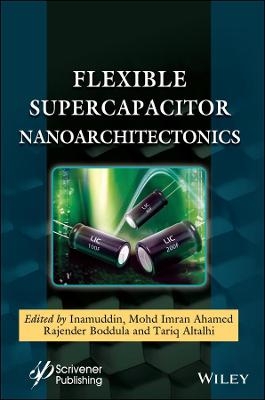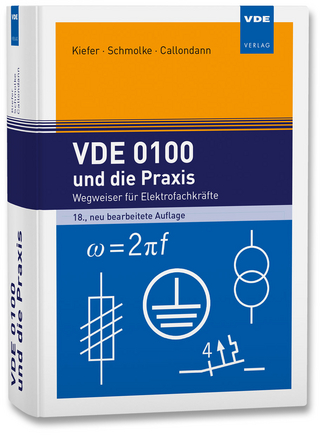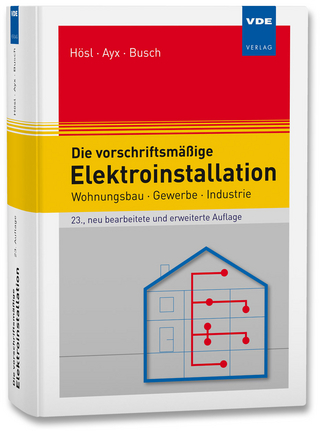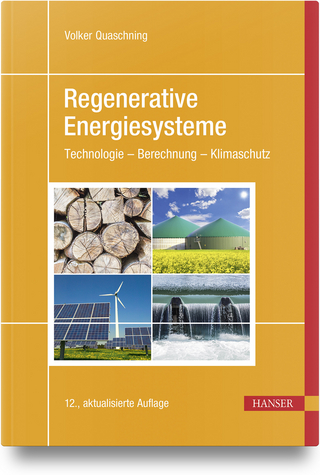
Flexible Supercapacitor Nanoarchitectonics
Wiley-Scrivener (Verlag)
978-1-119-71145-2 (ISBN)
- Titel z.Zt. nicht lieferbar
- Versandkostenfrei innerhalb Deutschlands
- Auch auf Rechnung
- Verfügbarkeit in der Filiale vor Ort prüfen
- Artikel merken
Inamuddin PhD is an assistant professor at King Abdulaziz University, Jeddah, Saudi Arabia and is also an assistant professor in the Department of Applied Chemistry, Aligarh Muslim University, Aligarh, India. He has extensive research experience in multidisciplinary fields of analytical chemistry, materials chemistry, electrochemistry, renewable energy and environmental science. He has published about 150 research articles in various international scientific journals, 18 book chapters, and edited 60 books with multiple well-known publishers. Mohd Imran Ahamed PhD is in the Department of Chemistry, Aligarh Muslim University, Aligarh, India. He has published several research and review articles in SCI journals. His research focuses on ion-exchange chromatography, wastewater treatment and analysis, actuators and electrospinning. Rajender Boddula PhD is currently working for the Chinese Academy of Sciences President’s International Fellowship Initiative (CAS-PIFI) at the National Center for Nanoscience and Technology (NCNST, Beijing). His academic honors include multiple fellowships and scholarships, and he has published many scientific articles in international peer-reviewed journals, edited books with numerous publishers and has authored 20 book chapters. Tariq Altalhi PhD is Head of the Department of Chemistry and Vice Dean of Science College at Taif University, Saudi Arabia. He received his PhD from the University of Adelaide, Australia in 2014. His research interests include developing advanced chemistry-based solutions for solid and liquid municipal waste management, converting plastic bags to carbon nanotubes, and fly ash to efficient adsorbent material.
Preface xvii
1 Electrodes for Flexible Integrated Supercapacitors 1
Sajid ur Rehman and Hong Bi
1.1 Introduction and Overview of Supercapacitors 2
1.2 Electrode Materials for Flexible Supercapacitors 4
1.2.1 Carbon Materials 4
1.2.1.1 Activated Carbon 4
1.2.1.2 Carbon Nanotubes 5
1.2.1.3 Graphene 6
1.2.1.4 Carbon Aerogels 8
1.2.1.5 Graphene Hydrogel 8
1.2.2 Conducting Polymers 10
1.2.3 Metal Compounds 13
1.2.3.1 Ruthenium Oxide (RuO2) Electrode Material 14
1.2.3.2 Nickel Oxide (NiO) Electrode Material 15
1.2.3.3 Copper Oxide (CuO) Electrode Material 16
1.2.3.4 Composite Electrode Materials 17
1.3 Device Architecture of Flexible Supercapacitor 18
1.4 Integration of Flexible Supercapacitors 19
1.5 Conclusion 21
References 22
2 Flexible Supercapacitors Based on Fiber-Shape Electrodes 27
Faiza Bibi, Muhammad Inam Khan, Abdur Rahim, Nawshad Muhammad and Lucas S.S. Santos
2.1 Introduction 27
2.2 Supercapacitors 29
2.2.1 Electrochemical Supercapacitor 29
2.2.2 Flexible Supercapacitors 30
2.3 Shape Dependent Flexible Electrodes 31
2.3.1 Porous 3D Flexible Electrodes 32
2.3.2 Flexible Paper Electrodes 32
2.3.3 Flexible Fiber Electrodes 33
2.4 Fiber Shape Electrodes (FE/FSC) 34
2.4.1 Wrapping Fiber Shape Electrode/Supercapacitors 34
2.4.2 Coaxial Fiber Shape Electrode/Supercapacitor 35
2.4.3 Parallel Fiber Shape Electrode/Supercapacitor 36
2.4.4 Twisted Fiber Shape Electrode/Supercapacitor 37
2.4.5 Rolled Fiber Shape Electrode/Supercapacitors 38
2.5 Conclusion 39
References 40
3 Graphene-Based Electrodes for Flexible Supercapacitors 43
Jyoti Raghav, Sapna Raghav and Pallavi Jain
3.1 Introduction 43
3.2 Type of SCs 44
3.2.1 EDLC 44
3.2.2 PCs 45
3.2.3 Flexible Graphene-Based Nano Composites 45
3.3 Fabrication Techniques for the Electrode Materials 46
3.3.1 Electrodeposition 46
3.3.2 Direct Coating (DC) 46
3.3.3 Chemical Vapor Deposition (CVD) 48
3.3.4 Hydrothermal 48
3.4 Substrate Materials for the Flexible SCs 48
3.5 Graphene Nanocomposite-Based Electrode Materials 49
3.5.1 Additives/Graphene Electrodes 49
3.5.2 Binder/Graphene Electrodes 49
3.5.3 Pure Graphene Electrode 50
3.5.4 Conductive Polymers/Graphene Composites Electrode 50
3.5.5 Metal or Metal Oxides (MOs) Composite Electrodes 51
3.6 NSs for the Flexible SC 52
3.7 Conclusion 53
Acknowledgment 54
References 54
4 Polymer-Based Flexible Substrates for Flexible Supercapacitors 59
Zul Adlan Mohd Hir, Shaari Daud, Hartini Ahmad Rafaie, Nurul Infaza Talalah Ramli and Mohamad Azuwa Mohamed
4.1 Introduction 60
4.2 Polymers-Based Flexible Materials for Flexible Supercapacitors 61
4.3 Synthesis and Fabrication Approach of the Polymer-Based Electrode 62
4.3.1 Preparation of Polymer-Based Electrode Materials 62
4.3.1.1 Polyaniline (PANI) 63
4.3.1.2 Polypyrrole (PPy) 65
4.3.1.3 Poly (3,4-ethylenedioxythiophene) (PEDOT) 66
4.3.2 Electrode Fabrication 69
4.4 Physicochemical Characterization of Flexible Supercapacitors 70
4.4.1 Scanning Electron Microscopy 70
4.4.2 Transmission Electron Microscopy 71
4.4.3 X-Ray Diffraction 73
4.4.4 Surface Area Analysis by BET (Brunauer, Emmett and Teller) 75
4.4.5 X-Ray Photoelectron Spectroscopy (XPS) 78
4.5 Recent Findings on the Performance of Flexible Supercapacitors 79
4.5.1 Electrochemical Double-Layer Capacitor (EDLC) 80
4.5.2 Pseudocapacitor 81
4.5.3 Hybrid Supercapacitor 83
4.6 Conclusion 86
References 87
5 Carbon Substrates for Flexible Supercapacitors and Energy Storage Applications 95
Seyyed Mojtaba Mousavi, Seyyed Alireza Hashemi, Najmeh Parvin, Chin Wei Lai, Sonia Bahrani, Wei-Hung Chiang and Sargol Mazraedoost
5.1 Introduction 96
5.2 Overview of the Energy Storage System 98
5.3 Capacitors Modeling 109
5.3.1 Equivalent Circuit Models 120
5.3.2 Intelligent Models 121
5.3.3 Self-Discharge 122
5.3.4 Fractional-Order Models 122
5.3.5 Thermal Modeling 123
5.4 Industrial Applications of Capacitors 124
5.4.1 Power Electronics 124
5.4.2 Uninterruptible Power Supplies 125
5.4.3 Hybrid Energy Storage 126
5.5 Conclusions 127
References 127
6 Organic Electrolytes for Flexible Supercapacitors 143
Younus Raza Beg, Gokul Ram Nishad and Priyanka Singh
6.1 Introduction 143
6.2 Organic Electrolytes 145
6.3 Solid and Quasi-Solid-State Electrolytes 150
6.3.1 PVA-Based Gel Electrolytes 154
6.3.2 PEG-Based Gel Electrolytes 156
6.3.3 PVDF-Based Gel Electrolytes 157
6.4 Ionic Liquids-Based Electrolytes 159
6.5 Redox Active Electrolytes 165
6.6 Conclusion 167
References 170
7 Carbon-Based Electrodes for Flexible Supercapacitors Beyond Graphene 177
Sunil Kumar and Rashmi Madhuri
7.1 Introduction 178
7.2 Materials Used to Prepare Flexible Supercapacitors 179
7.2.1 Carbon Materials 180
7.2.1.1 Activated Carbon (AC) 180
7.2.1.2 Carbon Nanotubes (CNTs) 180
7.2.1.3 Graphene 181
7.2.1.4 Carbon Aerogel 181
7.2.2 Conducting Polymer 181
7.2.3 Metal Oxide 182
7.3 The Carbon-Based Electrode Used for Flexible Supercapacitors 182
7.3.1 Carbon Nanotube (CNT)-Based Materials 182
7.3.1.1 CNT-Conducting Polymer Composite as Supercapacitors 182
7.3.1.2 CNT–Metal Oxide Composite as Supercapacitors 185
7.3.2 Activated Carbon-Based Materials 191
7.3.2.1 Activated Carbon-Conducting Polymer Composite as a Supercapacitor 191
7.3.2.2 Activated Carbon–Metal Oxide Composite as a Supercapacitor 195
7.4. Conclusion 201
References 201
8 Biomass-Derived Electrodes for Flexible Supercapacitors 211
Selvasundarasekar Sam Sankar and Subrata Kundu
8.1 Introduction 211
8.1.1 Electrode Materials for Flexible Supercapacitors 213
8.2 Biomass-Derived Carbon Materials 214
8.2.1 Activation 214
8.2.1.1 Physical Activation 215
8.2.1.2 Chemical Activation 215
8.2.1.3 Other Activation 218
8.2.2 Carbonization 218
8.2.2.1 Hydrothermal Method 218
8.2.2.2 Pyrolysis Method 219
8.3 Incorporation of Biomass-Based Electrodes in Flexible Supercapacitors 220
8.4 Challenges for Using Biomass-Derived Materials 222
8.5 Conclusion 224
References 225
9 Conducting Polymer Electrolytes for Flexible Supercapacitors 233
Aqib Muzaffar, M. Basheer Ahamed and Kalim Deshmukh
9.1 Introduction 234
9.2 Components of a Supercapacitor 236
9.2.1 Electrodes 236
9.2.2 Electrolytes 237
9.2.3 Separator 238
9.2.4 Current Collectors 239
9.2.5 Sealants 239
9.3 Configuration of a Supercapacitor 240
9.4 Conducting Polymer Electrolytes 241
9.4.1 Gel Conducting Polymer Electrolytes 243
9.4.2 Ionic Liquid-Based Conducting Polymer 246
9.4.3 OH− Ion Conducting Polymers 247
9.5 Conclusion 252
References 252
10 Inorganic Electrodes for Flexible Supercapacitor 263
Muhammad Inam Khan, Faiza Bibi, Muhammad Mudassir Hassan, Nawshad Muhammad, Muhammad Tariq and Abdur Rahim
10.1 Introduction 264
10.2 Flexible Inorganic Electrode Based on Carbon Nanomaterial 265
10.2.1 Carbonaceous Material 265
10.2.1.1 Graphene 266
10.2.1.2 Graphene Oxide-Based Electrodes 268
10.2.1.3 Carbon Nanotubes 269
10.2.1.4 Carbon Films/Textiles 271
10.3 Conclusion 272
References 273
11 New-Generation Materials for Flexible Supercapacitors 277
P.E. Lokhande, U.S. Chavan, Suraj Bhosale, Amol Kalam and Sonal Deokar
11.1 Introduction 277
11.2 Taxonomy of Supercapacitor 278
11.3 Fundamentals of Supercapacitor 280
11.4 Flexible Supercapacitor 282
11.4.1 Graphene-Based Flexible Supercapacitor 282
11.4.2 Metal Oxide/Hydroxide-Based Flexible Supercapacitor 284
11.4.3 Conducting Polymer-Based Flexible Supercapacitor 290
11.5 Outlook and Perspectives 298
Acknowledgement 303
References 303
12 Asymmetric Flexible Supercapacitors: An Overview of Principle, Materials and Mechanism 315
Sabina Yeasmin and Debajyoti Mahanta
12.1 Introduction: Why Store Energy? 316
12.2 Supercapacitor: A Green Approach Towards Energy Storage 316
12.3 Flexible Supercapacitors 319
12.3.1 Solid Electrolytes 320
12.3.2 Flexible Electrodes 322
12.3.3 Cell Designs for Flexible Supercapacitor 324
12.4 Asymmetric Supercapacitor 325
12.4.1 Principle, Material and Mechanism 325
12.4.2 Performance Evaluation in Asymmetric Supercapacitor 330
12.5 Recent Advances in Flexible Asymmetric Supercapacitors 333
12.6 Conclusion 335
References 335
13 Aqueous Electrolytes for Flexible Supercapacitors 349
Dipanwita Majumdar
13.1 Introduction 350
13.1.1 Influence of Electrolytes on Performance of Supercapacitors 352
13.1.2 What is an Ideal Electrolyte? 354
13.1.3 Classes of Electrolytes for Supercapacitors 355
13.2 Electrolyte Performance-Controlling Parameters for Designing Flexible Supercapacitors 357
13.2.1 Large Electrochemical Stability 357
13.2.2 High Ionic Conductivity 357
13.2.3 Nature of Electrolyte 358
13.2.4 Dielectric Constant and Viscosity of Solvent 358
13.2.5 Low Melting and High Boiling Points 359
13.2.6 High Chemical Stability 360
13.2.7 High Flash Point 360
13.2.8 Low Cost and Availability 360
13.2.9 Influence of Pressure 360
13.2.10 Influence of Binder 361
13.3 Why Aqueous Electrolytes? 362
13.4 Acid Electrolytes 363
13.4.1 EDLC and Pseudocapacitor Electrode Materials Employing H2SO4 Aqueous Electrolyte 375
13.4.2 H2SO4 Electrolyte-Based Nanocomposite Electrode Material Supercapacitors 377
13.4.3 H2SO4 Electrolyte-Based Hybrid Supercapacitors 377
13.5 Alkaline Electrolytes 378
13.5.1 Alkaline Electrolyte-Based EDLC and Pseudocapacitors 379
13.5.2 Alkaline Electrolyte-Based Nanocomposite Supercapacitors 381
13.5.3 Alkaline Electrolyte-Based Hybrid Supercapacitors 383
13.6 Neutral Electrolyte 383
13.6.1 Neutral Salt Aqueous Electrolyte-Based EDLC and Pseudocapacitors 384
13.6.2 Neutral Salt Aqueous Electrolyte-Based Nanocomposite Supercapacitors 387
13.6.3 Neutral Electrolyte-Based Hybrid Supercapacitors 388
13.7 Comparative Electrochemical Performances in Different Aqueous Electrolytes 388
13.8 Water-in-Salt Electrolytes for Flexible Supercapacitors 394
13.9 Conclusion and Future Prospects 395
Acknowledgements 396
References 396
14 Electrodes for Flexible Micro-Supercapacitors 413
Subrata Ghosh, Jiacheng Wang, Gustavo Tontini and Suelen Barg
14.1 Introduction 413
14.2 Electrode Configurations 414
14.2.1 Sandwich μSCs 414
14.2.2 Fiber or Wire μSC 415
14.2.2.1 Parallel 416
14.2.2.2 Twisted or Two-Ply 417
14.2.2.3 Coaxial 417
14.2.2.4 Rolled 417
14.2.2.5 All-in-One 418
14.2.3 Interdigitated μSCs 418
14.3 Manufacturing Techniques 421
14.3.1 Photolithography 421
14.3.2 Electrodeposition 422
14.3.3 Laser Direct-Writing 422
14.3.3.1 Laser Carving 423
14.3.3.2 Laser Scribing 423
14.3.3.3 Laser Transfer Method 424
14.3.4 Printing 425
14.3.4.1 Screen Printing 426
14.3.4.2 Inkjet Printing 427
14.3.4.3 3D Printing 428
14.4 State-of-the-Art Electrode Materials 431
14.4.1 Nanocarbons 431
14.4.2 MXenes 433
14.4.3 Transition-Metal Chalcogenides 435
14.4.4 Metal-Based Materials 435
14.4.5 Conducting Polymers 438
14.4.6 Composites or Hybrid Structures 440
14.4.7 Symmetric vs Asymmetric 441
14.5 Conclusion and Outlook 445
Acknowledgement 446
References 447
15 Electrodes for Flexible Self-Healable Supercapacitors 461
Ayesha Taj, Rabisa Zia, Sumaira Younis, Hunza Hayat, Waheed S. Khan and Sadia Z. Bajwa
15.1 Introduction 462
15.1.1 Supercapacitors 463
15.1.2 Electric Double Layer Capacitors (EDLCs) 464
15.1.3 Hybrid Capacitors 467
15.2 Self-Healable Nanomaterials 468
15.2.1 Metallic Nanomaterials 468
15.2.2 Non-Metallic/Carbon-Based Nanomaterials 470
15.2.3 Conducting Polymer-Based Nanomaterials 471
15.3 Nanomaterials-Based Interfaces for Supercapacitors 472
15.3.1 Metal Nanomaterials-Based Interfaces for Supercapacitors 473
15.3.2 Graphene-Based Interfaces for Self-Healable Supercapacitors 474
15.3.3 CNT/GO/PANI Composites Supercapacitors 478
15.4 Conclusion 479
References 480
16 Electrodes for Flexible–Stretchable Supercapacitors 485
Ravi Arukula, Pawan K. Kahol and Ram K. Gupta
16.1 Introduction 486
16.1.1 Supercapacitors and Energy Storage Mechanisms 487
16.1.2 Flexible/Stretchable Supercapacitors 489
16.2 Electrodes for Flexible/Stretchable Supercapacitors 490
16.2.1 Metal Oxide-Based Flexible/Stretchable Supercapacitors 491
16.2.1.1 Vanadium-Based Flexible Electrodes 493
16.2.1.2 Manganese-Based Flexible/Stretchable Electrodes 494
16.2.1.3 Ruthenium-Based Flexible Electrodes 496
16.2.1.4 Other Metal Oxides-Based Flexible Electrodes 498
16.2.2 2D Materials-Based Flexible/Stretchable Supercapacitors 499
16.2.3 Carbon-Based Flexible/Stretchable Supercapacitors 504
16.2.4 Conductive Polymer-Based Flexible/Stretchable Supercapacitors 505
16.2.5 Hybrid Composites-Based Flexible/Stretchable Supercapacitors 507
16.3 Conclusion and Future Remarks 511
References 512
17 Fabrication Approaches of Energy Storage Materials for Flexible Supercapacitors 533
Mohan Kumar Anand Raj, Rajasekar Rathanasamy, Prabhakaran Paramasivam and Santhosh Sivaraj
Abbreviations 533
17.1 Intoduction 534
17.2 Classification of Flexible Supercapacitors 536
17.2.1 Materials 536
17.2.1.1 Carbon 536
17.2.1.2 Metal Oxides 537
17.2.1.3 Conducting Polymers 537
17.2.1.4 Composites 537
17.2.2 Fabrication Methods 538
17.2.2.1 Electro-Chemical Deposition Method 538
17.2.2.2 Chemical Bath Deposition (CBD) Process 539
17.2.2.3 Inkjet Printing 540
17.2.2.4 Spray Deposition Method 541
17.2.2.5 Sol–Gel Technique 542
17.2.2.6 Direct Writing Method 543
17.3 Conclusion 544
References 545
18 Nature-Inspired Electrodes for Flexible Supercapacitors 549
Aqib Muzaffar, M. Basheer Ahamed and Kalim Deshmukh
18.1 Introduction 549
18.2 Energy Storing Mechanism of Supercapacitors 552
18.2.1 Electrostatic Double Layer Capacitor (EDLC) 554
18.2.2 Pseudocapacitor 555
18.2.3 Hybrid Supercapacitor 556
18.3 Flexible Supercapacitors 557
18.4 Essential Parameters of Supercapacitors 560
18.4.1 Energy Density Parameter 560
18.4.2 Power Density Parameter 561
18.5 Natural Flexible Supercapacitors 561
18.6 Conclusion 565
References 565
19 Ionic Liquid Electrolytes for Flexible Supercapacitors 575
Udaya Bhat K. and Devadas Bhat Panemangalore
Abbreviations 575
19.1 Introduction 577
19.2 Mobile Energy Storage Systems and Supercapacitors 578
19.3 Flexible Supercapacitors: Need and Challenges 580
19.4 Developments in the Design of a Supercapacitor 581
19.5 Electrolytes for Flexible Supercapacitors 583
19.5.1 Aqueous Electrolytes 583
19.5.2 Solid Electrolytes 584
19.5.3 Liquid Electrolytes 584
19.5.4 Ionic Liquid (IL) Electrolytes 585
19.6 Gel Polymer Electrolytes (GPEs) 586
19.7 Development in ILEs 588
19.8 Design Flexibility With IL Electrolytes 594
19.9 Electrolyte–Electrode Hybrid Design 596
19.10 Ionic Liquid Electrolytes and Problem of Leakage 597
19.11 Mechanical Stability of ILs 597
19.12 Conclusions 598
References 598
20 Conducting Polymer-Based Flexible Supercapacitor Devices 611
nand I. Torvi, Satishkumar R. Naik, Sachin N. Hegde, Mohemmedumar Mulla, Ravindra R. Kamble, Geoffrey R. Mitchell and Mahadevappa Y. Kariduraganavar
20.1 Introduction 612
20.2 Principles of Supercapacitor 612
20.3 Classification of Supercapacitors 613
20.3.1 Electrochemical Double-Layer Capacitors 613
20.3.2 Pseudocapacitors 613
20.3.2.1 Conducting Polymers 614
20.4 Conducting Polymer-Based Flexible Supercapacitors 615
20.4.1 Polyaniline-Based Flexible Supercapacitors 616
20.4.2 Polypyrrole-Based Flexible Supercapacitors 618
20.4.3 Polythiophene and its Derivatives-Based Flexible Supercapacitors 621
20.5 Electrolytes for Flexible Supercapacitors 624
20.6 Conclusions and Future Perspectives 626
Acknowledgements 626
References 626
Index 635
| Erscheinungsdatum | 10.08.2021 |
|---|---|
| Sprache | englisch |
| Maße | 10 x 10 mm |
| Gewicht | 454 g |
| Themenwelt | Technik ► Elektrotechnik / Energietechnik |
| Technik ► Maschinenbau | |
| ISBN-10 | 1-119-71145-2 / 1119711452 |
| ISBN-13 | 978-1-119-71145-2 / 9781119711452 |
| Zustand | Neuware |
| Informationen gemäß Produktsicherheitsverordnung (GPSR) | |
| Haben Sie eine Frage zum Produkt? |
aus dem Bereich


